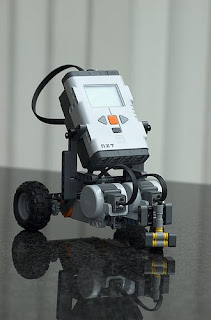Right Face
We will learn how to make our robot turn in two different methods. Each type of turn has specific uses. The two types of turns are Point Turn and Swing Turn.
Objectives
- Model the robot’s behavior using human actions (turning and going forward)
- Program the Personal Assistant robot to make two types of turns
- Investigate the relationship between programmatic motor settings and overall robot behavior
- Program a robot to turn using the LEGO MINDSTORMS programming environment
- Connect the robot to the computer and download programs to it
- Navigate to and run programs on the NXT
- Make the robot do both left and right turns, as well as one wheel (“swing”) and in-place (“point”)turns


